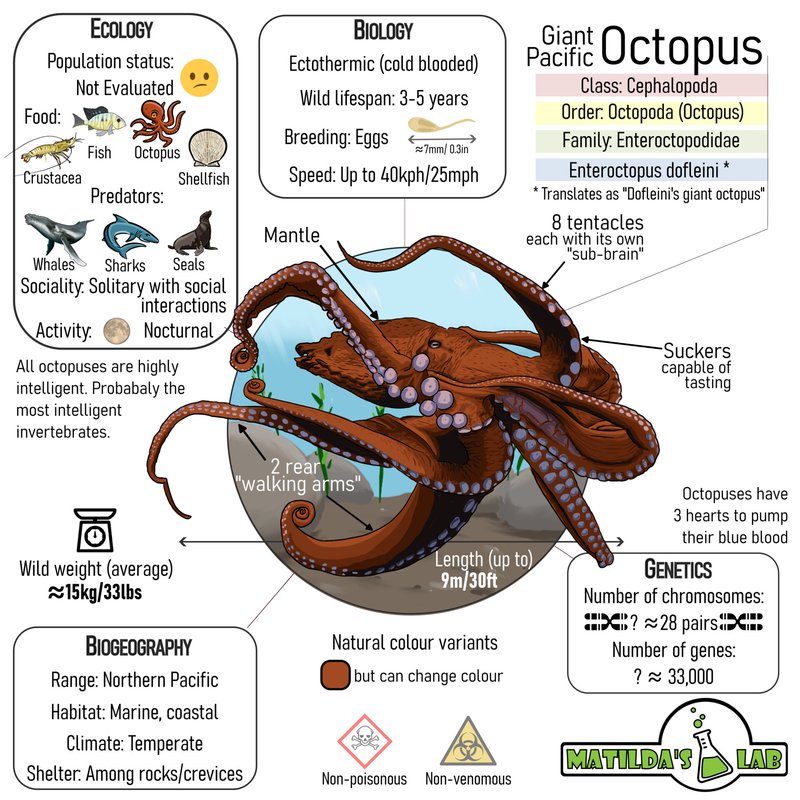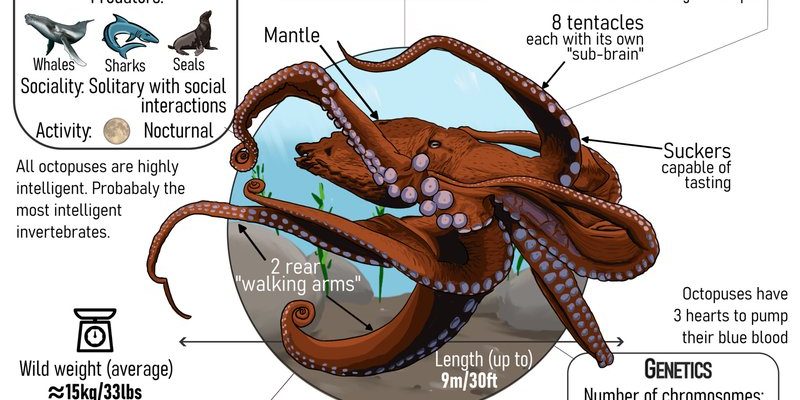
The Giant Pacific octopus is a true marvel of the sea. With its mesmerizing colors, incredible intelligence, and unusual way of moving, it captures the curiosity of marine enthusiasts and scientists alike. But how did it come to be? Let’s take a deep dive into its evolutionary history and explore the twists and turns that brought this creature to life.
What Is the Giant Pacific Octopus?
The Giant Pacific octopus (Octopus dofleini) is the largest species of octopus in the world. Typically, these octopuses can weigh between 50 to 110 pounds and have an arm span of up to 14 feet. That’s like having an umbrella that can cover a small car! They are primarily found in the chilly waters of the Pacific Ocean, from Alaska all the way down to California.
These octopuses are known for their impressive problem-solving skills. It’s like watching a child figure out a puzzle. They can open jars, escape enclosures, and can even use tools! Their ability to camouflage with their surroundings leaves many fish scratching their heads, wondering where they went. They have a unique body structure that allows them to squeeze into tight spaces, making them ultimate escape artists.
Ancient Lineage: The Origins of Cephalopods
To understand where the Giant Pacific octopus comes from, we must look back in time—millions of years, in fact. Cephalopods, the class of mollusks that includes octopuses, squids, and cuttlefish, first appeared around 500 million years ago during the Cambrian period. That’s a long time, isn’t it? Over the eons, they evolved into various forms, with some living in the ocean depths while others found their niche in shallower waters.
Here’s the thing: the ancestors of the Giant Pacific octopus were very different from what we see today. Early cephalopods had hard shells, much like modern-day nautiluses. Over time, some species developed soft bodies and the ability to lose their shells completely. This transition allowed them to become more agile and versatile in their underwater habitats. Imagine a creature that was once confined to a rigid shell bursting free into a world of movement and flexibility!
Environmental Factors and Adaptation
The evolution of the Giant Pacific octopus has been shaped by various environmental factors. Ocean temperatures, predators, and food availability play vital roles in how these octopuses adapt and survive. For instance, the cold waters of the Pacific have influenced their body functions, enabling them to thrive in low temperatures while many other species would struggle.
Adaptation doesn’t just stop at physical changes. The octopus’s intelligence is another evolutionary advantage. In an ocean full of predators like sharks and large fish, being smart helps them evade danger. Their remarkable camouflage skills allow them to blend seamlessly into rocky crevices and coral reefs, making them nearly invisible. Think of it as nature’s version of hide-and-seek!
Behavior and Intelligence: The Brain Behind the Arms
Now, let’s talk about behavior. The Giant Pacific octopus is not just a pretty face; it’s also incredibly smart. With around 500 million neurons in its body, a large portion of which is located in its arms, it functions differently than most creatures. Each arm can independently explore, touch, and even taste. This unique setup offers a fascinating glimpse into how intelligence has evolved in these mollusks.
You might be wondering how they use this intelligence. Well, here are a few ways:
- Problem Solving: They can open jars and navigate mazes, often showcasing exceptional skills previously thought to be exclusive to mammals.
- Social Interaction: Studies have shown that they may communicate with one another through body language and color changes.
- Learning: They can learn from experience, which is rare in the animal kingdom. For example, if one octopus encounters a dangerous predator, others can quickly learn to avoid that area.
Reproduction: Surviving the Next Generation
Reproduction in the Giant Pacific octopus is one of the most intriguing parts of its life cycle. After mating, the female lays thousands of eggs and then dedicates her life to protecting them. She clings to the eggs, ensuring they stay clean and oxygenated, but in doing so, she essentially stops eating. It’s a noble yet bittersweet sacrifice. Once the young hatch, the mother often dies shortly afterward. It’s nature’s way of ensuring that she gives everything for the next generation.
During this period, the attached eggs can take up to six months to hatch, depending on water temperature. After hatching, the baby octopuses are independent and must fend for themselves right from the start. It’s a tough world out there, but these youngsters are biologically equipped to navigate it, even without their mother’s guidance.
Current Threats and Conservation Efforts
Despite their incredible adaptations, Giant Pacific octopuses face several threats today. Overfishing, habitat destruction, and climate change pose significant challenges to their survival. As temperatures rise in the ocean and their habitats change, these octopuses must continue to adapt or risk diminishing populations.
Here’s where conservation comes into play. Organizations are working hard to protect the marine environments these octopuses call home. Initiatives like creating marine protected areas (MPAs) can help ensure that they have safe spawning grounds and can thrive without human interference. You can also contribute by being mindful of your seafood choices and supporting sustainable fishing practices. Every little bit helps!
The Future of the Giant Pacific Octopus
So, what’s next for the Giant Pacific octopus? Well, it all comes down to our commitment to protecting the oceans. As we continue to learn about their incredible evolutionary journey, we can appreciate not only their beauty but their importance in marine ecosystems. By safeguarding their habitats, we’re not just helping octopuses; we’re preserving the entire underwater community that depends on them.
In conclusion, the story of the Giant Pacific octopus is a testament to the complexities of evolution and survival. From their ancient ancestors to their clever behavior today, these creatures embody the adaptability and resilience of life underwater. The next time you think about an octopus, remember—they’re not just tentacled wonders of the sea; they’re a vital part of a rich, interconnected ecosystem that deserves our respect and protection.

